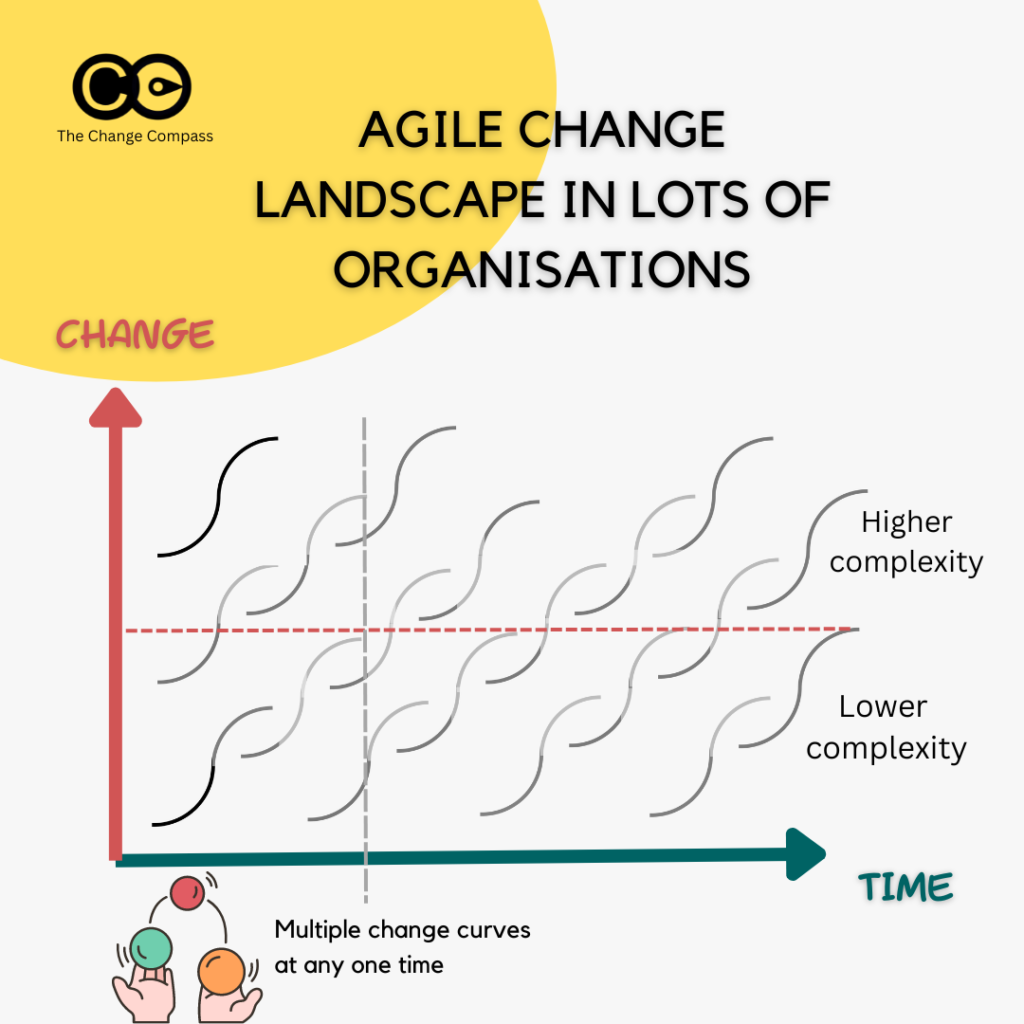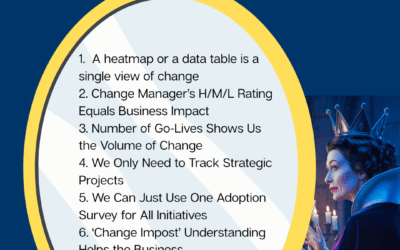There is no change curve. A single change curve doesn’t exist in most organisations. The concept of a single change curve means you’re always looking at it from the myopic lens of a single project or a single change. If we adopt a humanistic and human-centred view, what we see is that at any one time there are likely multiple change curves happening, to the same person, the same team, the same organisation.
At any one time, an impacted stakeholder maybe undergoing the 3rd iteraction of changes in one project, whilst partially adopting the new behaviours of another project, whilst just learning about the details of yet another project. And it may not even be projects or programs. It could be smaller team-led continuous improvement initiatives.
The concept of Agile methodology has revolutionized the way organizations approach software development and project management. It emphasizes flexibility, adaptability, and continuous improvement. However, the frequent introduction of multiple Agile changes within an organization can lead to multiple ‘S’ curves, which can result in several challenges related to adoption and business performance and capacity.
Multiple S curves refer to the continuous introduction of new Agile changes, each of which leads to a new adoption process and a corresponding performance improvement. This results in a series of S-shaped curves, each representing a different stage of the Agile adoption process.
The S curve is assuming that all of the changes are well implemented with good people experiences. The initial curve shows the slowness of the change adoption in the beginning, followed by a faster change adoption process, and finally capering off.
However, when the change is not well implemented due to various reasons the experience can be more like a V curve, where the experience and performance dips down into the ‘valley of despair’, followed by a ramp-up of improving experiences and change adoption.
The introduction of multiple Agile changes within an organization can lead to several challenges related to adoption and business performance and capacity. Firstly, continuous change can lead to confusion and uncertainty among employees. It can be difficult for employees to keep up with the latest changes and understand how they should adjust their work processes accordingly. This can result in decreased productivity and morale among employees.
Moreover, frequent changes can also result in increased cognitive strain and workload for employees. They may need to continuously learn new processes and techniques, leading to burnout and decreased job satisfaction.

Another challenge of having multiple Agile changes is that it can lead to decreased consistency in processes and outcomes. Each change may result in different outcomes and different ways of working, making it difficult to standardize and measure performance. This can result in a lack of accountability and a decrease in the organization’s overall efficiency.
In addition to the challenges related to adoption and performance, multiple Agile changes can also result in a decreased business capacity. The frequent changes can disrupt established workflows, making it difficult for teams to complete projects in a timely manner. This can lead to decreased project velocity and increased project risk, making it challenging for the organization to meet its goals and objectives.
So, while Agile methodology is a powerful tool for organizations, the frequent introduction of multiple Agile changes can result in several challenges related to adoption, performance, and capacity. To mitigate these challenges, organizations should take a strategic approach to Agile adoption, ensuring that changes are well-planned, communicated effectively, and implemented in a controlled manner. By doing so, organizations can ensure that the benefits of Agile methodology are realized while minimizing the risks associated with multiple changes.
To truly manage the multiple change curves, data is key. Without understanding which change curves are happening at what time it is not possible to manage change holistically. With data, you can easily drill into what is happening when, to whom, to what extent, and in what way. It is only with data that we can effectively orchestrate change across the board.

If you are going on a journey to capture change impacts across the organisation, be aware of how you are capturing the data so that you are truly addressing business issues critical to the organisation. For example:
- Ensure that the data captured can be easily formatted and visualised to support a range of business decision-making contexts without too much manual work. The more manual the set up of the data is, the more time and effort it requires to answer the various data cuts that stakeholders may be needing
- Balancing critical data points required versus having too many data fields and therefore too Cumberland and difficult to capture the data. The more data you are required to collect, the more complex the process is for those whom you are collecting the data from
- Thanks to the nature of agile projects, the data will change constantly. The tracking of constantly changing change data is critical. However, it should also be easy and quick to update the data
- Organisations under changes will invariably have changes in organisational structures, teams or roles. Ensure that your data-capturing process makes it easy to update the structure as they change.
Have a chat with us to understand more about how to leverage digital solutions to multiple change impacts across the organisation, and how to leverage AI and automation to make your lives easier in leveraging a data platform to make critical business decisions using change impact data.
So next time you talk about THE change curve, just be aware that you’re likely not adopting a people-centric view of change. You may want to look more holistically at what your impacted stakeholders are undergoing or about to undergo. Adopt a holistic mindset of what impacted stakeholders are going through as you plan out your change approach.
If you’re interested in exploring more about managing agile changes check out the following:
How to deliver constant changes as a part of agile change management






